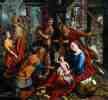![]()
 The Adoration of the Magi
The Adoration of the Magi
Middle panel of a triptych The Adoration of the Magi; c. 1560; Oil (?) on panel, 167.5 x 179 cm; Rijksmuseum, Amsterdam
The baby Jesus is sitting on the lap of his mother, the Virgin Mary. He is holding his hand up in a blessing. Before him kneels a king offering a gift of gold. This is Melchior, the oldest of the three kings who came to pay homage to the infant Christ. Behind Mary, in a red gown is her husband Joseph. According to tradition, Jesus was born in a stable. The donkey, the ox and the shabby straw roof remind us of this. The scene takes place against the background of a ruined palace with marble columns and steps. This refers to King David, a distant ancestor of Jesus. The ruin is symbolic and represents the old world: Jesus represents the new, Christian world.
Pieter Aertsen painted this large, colourful panel in around 1560. It is a varied scene with many attractive details such as the rather homely basket of clothes beside Mary and the king's entourage with camels on the left of the background.
Only one of the three kings is pictured on this panel. In fact, the painting is no longer complete. It was originally the centre panel of an altarpiece. The other two kings were pictured on the side panels. The right-hand panel has been lost. The left-hand panel, depicting the Moorish King Caspar and his entourage, has been preserved. This king is offering a vase of myrrh, a fragrant resin which was employed in the ancient world in perfume. It was used in preparing myrrh balsam, for embalming corpses. According to tradition, this was what Caspar, the African king, gave to Christ. It is viewed as a reference to Christ's subsequent death.
Aertsen has depicted the figures in all sorts of different attitudes, which sometimes appear rather forced. In the background are a number of men - servants from the king's entourage - in various stages of undress. The most remarkable is the naked camel driver in the middle panel. Here the artist is obviously showing off his skill in anatomy and his knowledge of examples from the Italian Renaissance and Classical Antiquity. The artificial attitudes, the contrived nude and the bright colours are characteristic of the style in which Aertsen worked - that of Mannerism.
 Artificial attitudes and contrived nude
Artificial attitudes and contrived nude